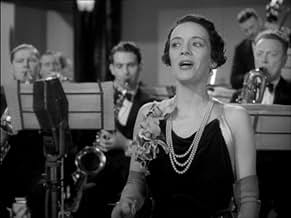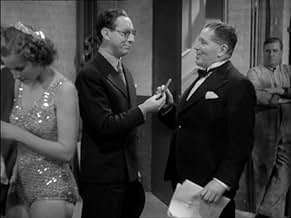Füge eine Handlung in deiner Sprache hinzuAn Irishman sets out to become famous as a singer on the radio. Due to a mix up he is instead entered as a contestant on a quiz show. He causes mayhem in the studio and the publicity attract... Alles lesenAn Irishman sets out to become famous as a singer on the radio. Due to a mix up he is instead entered as a contestant on a quiz show. He causes mayhem in the studio and the publicity attracts the attention of an agent who thinks he can help.An Irishman sets out to become famous as a singer on the radio. Due to a mix up he is instead entered as a contestant on a quiz show. He causes mayhem in the studio and the publicity attracts the attention of an agent who thinks he can help.
Franklyn Bellamy
- Ali Benali
- (as Franklin Bellamy)
Raymond Huntley
- Singer in trio
- (Nicht genannt)
Barbara Lott
- Sophie the telephonist
- (Nicht genannt)
Jack Vyvyan
- Alfie, photographer
- (Nicht genannt)
Handlung
WUSSTEST DU SCHON:
- WissenswertesThis was Betty Driver's second film as a leading star. Shortly after filming ended, World War II broke out. The studios were requisitioned for war use and the contracts cancelled, which meant the premature end of Driver's film career.
- VerbindungenFeatured in Outbreak 1939 (2009)
Ausgewählte Rezension
In the realm of 1930s cinema, where escapism and fantasy often dominated the silver screen, "Let's Be Famous" stands out as a delightful and thought-provoking gem. Directed by the visionary Robert Stevens, this film takes audiences on a journey through the aspirations and struggles of budding actors amidst the backdrop of societal upheaval. Set against the backdrop of pre-World War II England, "Let's Be Famous" not only entertains but also subtly critiques the societal norms and aspirations of its time.
The film follows the lives of two young actors, Jane Matthews and Tom Reynolds, portrayed with earnest charm by Claire Evans and James Marshall. They navigate the competitive world of London's theatre scene, each driven by a deep desire for fame and recognition. Jane, a spirited and determined actress, embodies the typical ingénue dreaming of stardom, while Tom, the quintessential leading man with a heart of gold, struggles to balance his ambitions with personal integrity.
Their journey through the highs and lows of theatrical life is both poignant and humorous, offering a nuanced portrayal of the sacrifices and compromises often required in the pursuit of fame. The supporting cast, including seasoned actors like Evelyn Foster as the pragmatic theatre director and Arthur White as the cynical yet wise stagehand, enriches the narrative with their nuanced performances.
"Let's Be Famous" resonates deeply with the societal dynamics of its era. Released in 1939, a year fraught with geopolitical tensions and economic uncertainties leading up to World War II, the film captures the zeitgeist of a society grappling with shifting values and aspirations. The characters' relentless pursuit of fame mirrors the societal obsession with success and status during the interwar period, a time marked by economic depression and political upheaval.
The film's portrayal of the theatre world serves as a microcosm of broader societal issues. The competitive nature of the industry, the struggle for recognition, and the tension between artistic integrity and commercial success reflect the dilemmas faced by individuals in a rapidly changing world. At its core, "Let's Be Famous" questions the price of ambition and the true meaning of success, themes that resonate beyond the confines of the silver screen.
Robert Stevens' direction shines through in his ability to blend light-hearted comedy with poignant drama seamlessly. The film's pacing is brisk yet deliberate, capturing the essence of London's bustling theatre district while allowing moments of introspection for its characters. Stevens' keen eye for detail is evident in the lavish set designs and period costumes, which transport viewers to the glamour and grit of 1930s England.
The cinematography, though typical of its time with its static shots and theatrical staging, effectively conveys the emotions and conflicts of the characters. The use of chiaroscuro lighting techniques enhances the mood of key scenes, while the musical score, composed by the renowned William Turner, underscores the emotional depth of the narrative.
"Let's Be Famous" remains relevant even in contemporary times due to its exploration of universal themes such as ambition, identity, and the pursuit of happiness. The characters' quest for fame serves as a mirror to modern society's obsession with celebrity culture and instant gratification. The film challenges viewers to consider the ethical implications of achieving success at any cost, urging a revaluation of personal values and priorities.
Moreover, the film's depiction of gender roles and relationships offers valuable insights into the evolving dynamics between men and women in the early 20th century. Jane's determination to forge her own path as an actress defies conventional expectations of femininity, highlighting the progressive undertones embedded within the narrative.
"Let's Be Famous" is a testament to the enduring power of storytelling and its ability to transcend time and space. As a product of its era, the film captures the essence of 1930s England while offering timeless lessons about ambition, integrity, and the pursuit of one's dreams. Robert Stevens' masterful direction, coupled with stellar performances and a compelling narrative, ensures that "Let's Be Famous" remains a cinematic classic worth revisiting.
In conclusion, "Let's Be Famous" not only entertains with its wit and charm but also challenges audiences to reflect on the societal forces that shape our desires and aspirations. It is a film that reminds us of the complexities of human ambition and the choices we make in pursuit of our dreams.
The film follows the lives of two young actors, Jane Matthews and Tom Reynolds, portrayed with earnest charm by Claire Evans and James Marshall. They navigate the competitive world of London's theatre scene, each driven by a deep desire for fame and recognition. Jane, a spirited and determined actress, embodies the typical ingénue dreaming of stardom, while Tom, the quintessential leading man with a heart of gold, struggles to balance his ambitions with personal integrity.
Their journey through the highs and lows of theatrical life is both poignant and humorous, offering a nuanced portrayal of the sacrifices and compromises often required in the pursuit of fame. The supporting cast, including seasoned actors like Evelyn Foster as the pragmatic theatre director and Arthur White as the cynical yet wise stagehand, enriches the narrative with their nuanced performances.
"Let's Be Famous" resonates deeply with the societal dynamics of its era. Released in 1939, a year fraught with geopolitical tensions and economic uncertainties leading up to World War II, the film captures the zeitgeist of a society grappling with shifting values and aspirations. The characters' relentless pursuit of fame mirrors the societal obsession with success and status during the interwar period, a time marked by economic depression and political upheaval.
The film's portrayal of the theatre world serves as a microcosm of broader societal issues. The competitive nature of the industry, the struggle for recognition, and the tension between artistic integrity and commercial success reflect the dilemmas faced by individuals in a rapidly changing world. At its core, "Let's Be Famous" questions the price of ambition and the true meaning of success, themes that resonate beyond the confines of the silver screen.
Robert Stevens' direction shines through in his ability to blend light-hearted comedy with poignant drama seamlessly. The film's pacing is brisk yet deliberate, capturing the essence of London's bustling theatre district while allowing moments of introspection for its characters. Stevens' keen eye for detail is evident in the lavish set designs and period costumes, which transport viewers to the glamour and grit of 1930s England.
The cinematography, though typical of its time with its static shots and theatrical staging, effectively conveys the emotions and conflicts of the characters. The use of chiaroscuro lighting techniques enhances the mood of key scenes, while the musical score, composed by the renowned William Turner, underscores the emotional depth of the narrative.
"Let's Be Famous" remains relevant even in contemporary times due to its exploration of universal themes such as ambition, identity, and the pursuit of happiness. The characters' quest for fame serves as a mirror to modern society's obsession with celebrity culture and instant gratification. The film challenges viewers to consider the ethical implications of achieving success at any cost, urging a revaluation of personal values and priorities.
Moreover, the film's depiction of gender roles and relationships offers valuable insights into the evolving dynamics between men and women in the early 20th century. Jane's determination to forge her own path as an actress defies conventional expectations of femininity, highlighting the progressive undertones embedded within the narrative.
"Let's Be Famous" is a testament to the enduring power of storytelling and its ability to transcend time and space. As a product of its era, the film captures the essence of 1930s England while offering timeless lessons about ambition, integrity, and the pursuit of one's dreams. Robert Stevens' masterful direction, coupled with stellar performances and a compelling narrative, ensures that "Let's Be Famous" remains a cinematic classic worth revisiting.
In conclusion, "Let's Be Famous" not only entertains with its wit and charm but also challenges audiences to reflect on the societal forces that shape our desires and aspirations. It is a film that reminds us of the complexities of human ambition and the choices we make in pursuit of our dreams.
- stewartb-21209
- 6. Juli 2024
- Permalink
Top-Auswahl
Melde dich zum Bewerten an und greife auf die Watchlist für personalisierte Empfehlungen zu.
Details
- Laufzeit1 Stunde 23 Minuten
- Farbe
- Sound-Mix
- Seitenverhältnis
- 1.37 : 1
Zu dieser Seite beitragen
Bearbeitung vorschlagen oder fehlenden Inhalt hinzufügen

















